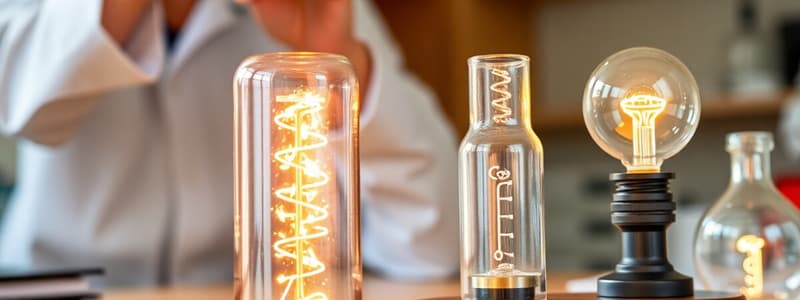Podcast
Questions and Answers
What is the primary purpose of the scientific method?
What is the primary purpose of the scientific method?
To systematically explore observations and answer questions through experimentation.
Explain the hypothesis step in the scientific method.
Explain the hypothesis step in the scientific method.
The hypothesis step involves developing a testable prediction, typically structured as an if-then statement.
Describe one example of energy transformation in everyday life.
Describe one example of energy transformation in everyday life.
Photosynthesis transforms solar energy into chemical energy in plants.
How does the law of conservation of energy relate to energy transformations?
How does the law of conservation of energy relate to energy transformations?
What are the three main states of matter?
What are the three main states of matter?
What distinguishes an open system from a closed system?
What distinguishes an open system from a closed system?
Provide an example of how energy can influence the state of matter.
Provide an example of how energy can influence the state of matter.
What are the two main types of energy mentioned in the content?
What are the two main types of energy mentioned in the content?
Flashcards are hidden until you start studying
Study Notes
The Scientific Method
- Definition: A systematic process for experimentation to explore observations and answer questions.
- Steps:
- Observation: Gather information and notice phenomena.
- Question: Formulate a question based on observations.
- Hypothesis: Develop a testable prediction (if-then statement).
- Experiment: Design and conduct experiments to test the hypothesis.
- Data Collection: Record and analyze data from experiments.
- Conclusion: Interpret results to accept, reject, or modify hypothesis.
- Communication: Share findings with the scientific community.
Energy Transformations
- Definition: The process of changing energy from one form to another.
- Types of Energy:
- Kinetic Energy: Energy of motion.
- Potential Energy: Stored energy based on position.
- Thermal Energy: Energy related to temperature and heat.
- Chemical Energy: Energy stored in chemical bonds.
- Nuclear Energy: Energy stored in atomic nuclei.
- Examples:
- Photosynthesis: Converts solar energy into chemical energy.
- Batteries: Chemical energy converted into electrical energy.
- Hydropower: Kinetic energy of flowing water converted into electrical energy.
- Law of Conservation of Energy: Energy cannot be created or destroyed, only transformed.
Matter and Energy
- Matter: Anything that has mass and occupies space.
- States of Matter: Solid, liquid, gas, and plasma.
- Properties: Physical (color, density) and chemical (reactivity).
- Energy: The capacity to do work or produce change.
- Relationship Between Matter and Energy:
- Matter can be converted into energy (e.g., matter-antimatter annihilation, nuclear fission and fusion).
- Energy can influence the state of matter (Heating can change solid to liquid).
- Systems:
- Open Systems: Exchange both matter and energy with surroundings.
- Closed Systems: Exchange energy but not matter.
- Isolated Systems: Do not exchange matter or energy with surroundings.
The Scientific Method
- A systematic process for exploring observations and answering questions through experimentation.
- Involves observing phenomena, formulating questions, developing testable predictions, designing experiments, collecting and analyzing data, drawing conclusions, and communicating findings.
Energy Transformations
- The process of changing energy from one form to another.
- Different types of energy include kinetic energy, potential energy, thermal energy, chemical energy, and nuclear energy.
- Kinetic energy is the energy of motion.
- Potential energy is stored energy based on position.
- Thermal energy is related to temperature and heat.
- Chemical energy is stored in chemical bonds.
- Nuclear energy is stored in atomic nuclei.
- Examples of energy transformations include photosynthesis, batteries, and hydropower.
- The Law of Conservation of Energy states that energy cannot be created or destroyed, only transformed.
Matter and Energy
- Matter is anything that has mass and occupies space.
- States of matter include solid, liquid, gas, and plasma.
- Properties of matter include physical (color, density) and chemical (reactivity).
- Energy is the capacity to do work or produce change.
- Matter can be converted into energy, as seen in nuclear reactions (fission, fusion).
- Energy can influence the state of matter, like heating a solid to change it into a liquid.
- Open systems exchange both matter and energy with their surroundings.
- Closed systems exchange energy but not matter.
- Isolated systems do not exchange matter or energy with their surroundings.
Studying That Suits You
Use AI to generate personalized quizzes and flashcards to suit your learning preferences.




